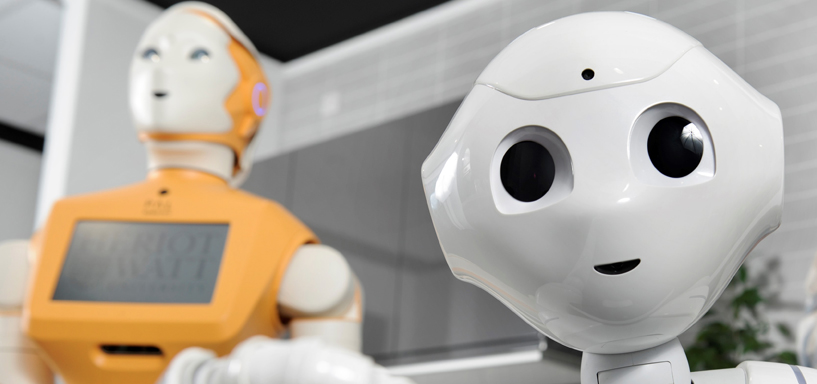
We’ve all privately wondered about a future with robots, haven’t we? Will it be loveable R2-D2 or The Terminator?
The American mathematician and electrical engineer Claude Shannon, known as the Father of the Information Age, amusingly exposed a secret human fear when he said: “I visualise a time when we will be to robots what dogs are to humans, and I’m rooting for the machines.”
Shannon died in 2001, contemplating a future vision where humans become a subordinate but affectionately tolerated species. But at the National Robotarium in Edinburgh – where they know a little bit more about what the future will look like because they’re developing it every day – they’d probably prefer Bill Gates’ take on things: “Robotics and other combinations will make the world pretty fantastic compared with today.”
The Microsoft founder’s view is one espoused by Lisa Farrell, of the National Robotarium, which opened in 2022, and is a government-funded partnership between Heriot-Watt University and Edinburgh University. It is based at Heriot-Watt’s campus in the west of the city, in a stunning £22.4 million facility with unrivalled laboratory space and testing facilities for the development of Artificial Intelligence and Robotics solutions.
Lisa said: “The key word here is ‘solutions.’ The Robotarium is all about harnessing the technologies to provide people-centred solutions to improve lives, create greater productivity and add competitive advantage.
“We’re working across all kinds of areas, but there are some of real focus such as health and social care, offshore energy, agriculture, and construction. We work with industry partners on providing good solutions to real problems. It’s a team effort that harnesses creativity, experience and technical innovation.” And it’s something we really need to embrace in this country because we are behind the curve compared to places like Japan, Germany, China and France in harnessing advances.
In industry, lack of investment in new technologies risks handing competitive advantage to other nations who are developing new ways of doing things at a faster pace than in this country. But the Robotarium aims to play a key role in rapidly closing that gap.
Few areas offer the potential for advancement as much as Health and Social Care. It is an area where AI and robotics can play a really enormous role in facilitating and changing the way we deliver care in future, freeing up the vital time of medics and carers to perform more meaningful tasks. But it can also help in a directly impactful way in preventing more serious situations developing.
One workstream which clearly illustrates this is the FEATHER project, which is developing systems to allow the earlier identification of urinary tract infections (UTIs) in the elderly and dementia sufferers. UTIs, if undetected, can quickly escalate into more serious conditions including higher levels of confusion including delirium.
The project is led by the University of Edinburgh’s School of Informatics in collaboration with the Robotarium. Smart sensors and data can alert individual family carers or professions to potential infection.
Lisa explained: “The system uses conversational AI – like Alexa – to converse with individuals needing care and uses things like pressure pads which can let us know when they have visited the bathroom. Using all of the data the system gathers, we can alert that person’s family carer, or the professional care team, if there is concern that they may be developing a UTI, for example through not drinking enough.” The work is attracting interest from as far away as Japan, where the issues of a growing ageing population is even more acute than in the UK.
Earlier diagnosis of UTIs, which affects 150 million people worldwide each year, can reduce costly emergency care, ensure the appropriate prescription of medication and improve the outcomes for patients.
Another healthcare project, being led by Touchlab Ltd, a start-up company based within the facility, sees the development of a human-like skin, to help robots develop a sense of touch. “Robots can see, hear and smell, but a sense of touch opens up new possibilities for help with care tasks. For example, something like brushing hair – a small thing, but something that might free up time for more meaningful human interaction for carers.”
A different illustration shows the impact the technologies can have on industries. Working with the fishing industry, the National Robotarium is working with leading experts in marine technology at Heriot-Watt to support the development of a smart technology trawl net system that will help fishermen avoid bycatch (catching the wrong species of sealife in their net).
Species quotas are a major issue for fishermen and the environment. The work is being funded by the UK Seafood Innovation Fund and delivered in partnership with Fisheries Innovation & Sustainability, “Smartrawl”, the brainchild of Professor Paul Fernandes, uses AI and robotics technology to monitor the species caught in a net, identify them, and using a remote-controlled robotic gate then retains or releases each marine animal depending on the trawler’s intended catch list.
It has already undergone extensive testing. The net result? Millions of tonnes of bycatch previously discarded, and often dead, can be avoided – a positive result for the sustainability of our oceans and for the fishing industry.


